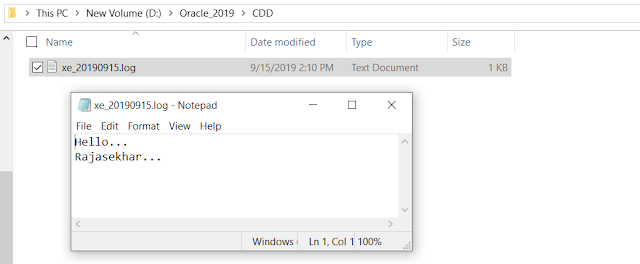Scripting:
-- Weakly or Loosely typed Programming Language
-- Interpreter Based
-- Less libraries available to perform installation
-- Special environment is not required for programming
-- Javascript, LiveScript, VBScript ,Shell Script, Perl Script
Programming:
-- Strictly typed Programming Language
-- Cimpiler Based
-- More libraries available and header files are mandatory to perform installation
-- Special environment and set up required for programming
-- Java,PL/SQL
Types of Shell:
Bourne Shell: Steven Bourne Shell Prompt is
$ and execution command is
sh
C Shell: University of California
Bill Joy Shell Prompt is
% and execution command is
Csh
Korn Shell: AT&T
David Korn Shell Prompt is
$ and execution command is
ksh
Default Shell is : bash
Type of shell scripting:
1) Interactive shell script - user has to pass inputs to program
2) Non-Interactive shell script - don't take inputs from user
[oracle@ODIGettingStarted ~]$ pwd
/home/oracle
[oracle@ODIGettingStarted ~]$ cd practice
[oracle@ODIGettingStarted practice]$ pwd
/home/oracle/practice
[oracle@ODIGettingStarted practice]$
To get the name of the shell:
[oracle@ODIGettingStarted practice]$ echo $0
bash
To switch to Korn (ksh) shell:
[oracle@ODIGettingStarted practice]$ ksh
$echo $0
ksh
$exit
User defined Variables :
[oracle@ODIGettingStarted practice]$ x=2019
[oracle@ODIGettingStarted practice]$ echo $x
2019
[oracle@ODIGettingStarted practice]$ echo $y
[oracle@ODIGettingStarted practice]$ y=2020
[oracle@ODIGettingStarted practice]$ echo $y
2020
[oracle@ODIGettingStarted practice]$
Declaring Global variable: (here x is accessible even if we switch to kourn/c shell)
[oracle@ODIGettingStarted practice]$ export x
System defined Variables:
[oracle@ODIGettingStarted practice]$ echo $HOME
/home/oracle
[oracle@ODIGettingStarted practice]$ echo $LOGNAME
oracle
[oracle@ODIGettingStarted practice]$ echo $USER
oracle
[oracle@ODIGettingStarted practice]$ echo $PS1
[\u@\h \W]\$
[oracle@ODIGettingStarted practice]$ echo $PS2
>
Why Scripting is Loosely or Weakly Typed language?
[oracle@ODIGettingStarted practice]$ vi MyFirstScript.sh
[oracle@ODIGettingStarted practice]$ cat MyFirstScript.sh
#It is My First Shell Script
echo "Welcome to the world of Shell Scripting"
echo 'Default Script is BASH'
echo Thank You..!!
[oracle@ODIGettingStarted practice]$ sh MyFirstScript.sh
Welcome to the world of Shell Scripting
Default Script is BASH
Thank You..!!
[oracle@ODIGettingStarted practice]$
Non-Interactive Shell Scripting Examples:
Why Scripting is Interpreter based?
[oracle@ODIGettingStarted practice]$ vi MyFirstScript.sh
[oracle@ODIGettingStarted practice]$ cat MyFirstScript.sh
#It is My First Shell Script
echo "Welcome to the world of Shell Scripting"
cho 'Default Script is BASH'
echo Thank You..!!
[oracle@ODIGettingStarted practice]$ sh MyFirstScript.sh
Welcome to the world of Shell Scripting
MyFirstScript.sh: line 3: cho: command not found
Thank You..!!
[oracle@ODIGettingStarted practice]$
Number of users logged in:
[oracle@ODIGettingStarted practice]$ users
oracle oracle oracle
[oracle@ODIGettingStarted practice]$ users | wc -w
3
[oracle@ODIGettingStarted practice]$ who | wc -l
3
[oracle@ODIGettingStarted practice]$ who -q
oracle oracle oracle
# users=3
[oracle@ODIGettingStarted practice]$ vi users.sh
[oracle@ODIGettingStarted practice]$ cat users.sh
#Number of users
echo Currently logged in users count is:` who | wc -l `
echo currently logged in users are: ` who -q `
echo logged in users count is : ` users | wc -w `
echo "Success"
[oracle@ODIGettingStarted practice]$
[oracle@ODIGettingStarted practice]$ sh users.sh
Currently logged in users count is:3
currently logged in users are: oracle oracle oracle # users=3
logged in users count is : 3
Success
[oracle@ODIGettingStarted practice]$
Number of files in the current directory that are existed:
[oracle@ODIGettingStarted practice]$ pwd
/home/oracle/practice
[oracle@ODIGettingStarted practice]$ ls
MyFirstScript.sh users.sh
[oracle@ODIGettingStarted practice]$ ls -ltr
total 8
-rw-rw-r--. 1 oracle oracle 124 Sep 13 11:44 MyFirstScript.sh
-rw-rw-r--. 1 oracle oracle 185 Sep 13 13:43 users.sh
[oracle@ODIGettingStarted practice]$ ls | wc -w
2
[oracle@ODIGettingStarted practice]$ ls | wc -l
2
[oracle@ODIGettingStarted practice]$ vi files.sh
[oracle@ODIGettingStarted practice]$ cat files.sh
#Number of files
echo "Number of files in the current directory:" `ls | wc -l`
echo "Success"
[oracle@ODIGettingStarted practice]$ sh files.sh
Number of files in the current directory: 3
Success
[oracle@ODIGettingStarted practice]$ ls -ltr
total 12
-rw-rw-r--. 1 oracle oracle 124 Sep 13 11:44 MyFirstScript.sh
-rw-rw-r--. 1 oracle oracle 185 Sep 13 13:43 users.sh
-rw-rw-r--. 1 oracle oracle 94 Sep 13 13:48 files.sh
[oracle@ODIGettingStarted practice]$
Is file extension is mandatory in Shell Scripting? Answer is : No
[oracle@ODIGettingStarted practice]$ vi noexten
[oracle@ODIGettingStarted practice]$ cat noexten
#script without file extension
echo "Welcome to BASH shell scripting"
echo Thank You!!
[oracle@ODIGettingStarted practice]$ sh noexten
Welcome to BASH shell scripting
Thank You!!
[oracle@ODIGettingStarted practice]$
Interactive Shell Scripting Examples:
[oracle@ODIGettingStarted practice]$ read a
5
[oracle@ODIGettingStarted practice]$ read b
10
[oracle@ODIGettingStarted practice]$ echo $a
5
[oracle@ODIGettingStarted practice]$ echo $b
10
[oracle@ODIGettingStarted practice]$ echo $a+$b
5+10
[oracle@ODIGettingStarted practice]$ echo $[a+b]
15
[oracle@ODIGettingStarted practice]$ read x
Raj
[oracle@ODIGettingStarted practice]$ echo $x
Raj
[oracle@ODIGettingStarted practice]$
echo
[oracle@ODIGettingStarted practice]$ vi read1.sh
[oracle@ODIGettingStarted practice]$ cat read1.sh
#Reading and displaying values
echo Enter your name:
read name
echo "Hello Mr./Mrs " $name
[oracle@ODIGettingStarted practice]$ sh read1.sh
Enter your name:
Rajasekhar
Hello Mr./Mrs Rajasekhar
[oracle@ODIGettingStarted practice]$
echo -n
[oracle@ODIGettingStarted practice]$ vi read1.sh
[oracle@ODIGettingStarted practice]$ cat read1.sh
#Reading and displaying values
echo -n Enter your name:
read name
echo "Hello Mr./Mrs " $name
[oracle@ODIGettingStarted practice]$ sh read1.sh
Enter your name:Rajasekhar
Hello Mr./Mrs Rajasekhar
[oracle@ODIGettingStarted practice]$
Arithmetic Operations:
[oracle@ODIGettingStarted practice]$ vi arithmetic.sh
[oracle@ODIGettingStarted practice]$ sh arithmetic.sh
Enter first number:10
Enter Second number:5
Sum of two numbers : 15
Difference of two numbers : 5
Product of two numbers: 50
[oracle@ODIGettingStarted practice]$ cat arithmetic.sh
#Arithmetic Operations
echo -n Enter first number:
read fno
echo -n Enter Second number:
read sno
echo Sum of two numbers : $[fno+sno]
echo Difference of two numbers : $[fno-sno]
echo Product of two numbers: $[fno*sno]
[oracle@ODIGettingStarted practice]$







